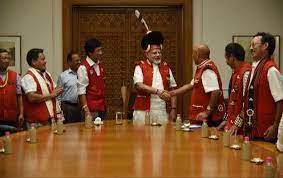New Delhi: Interacting with a group of young women students from Nagaland, Prime Minister Narendra Modi applauded the rich cultural traditions associated with the ‘Gaon Burah’ — village elders – institutions in the state and, in the process, made a big political statement.
Empowering of village bodies like Gaon Burah institutions in Nagaland or village panchayats in Jammu and Kashmir has been debated time and again.
By 2016, it was learnt that the PMO took a keen interest in the functioning of the influential and much respected Gaon Burah bodies in Nagaland.
R.N. Ravi as interlocutor on Naga peace talks was reportedly instructed to enlist the views of Naga people and villagers at the grassroots levels.
The ‘importance’ given to Naga Gaon Burahs did not go down well with many other established players in the existing power politics structures during the tenure of R.N. Ravi as the Governor.
Many, however, see empowering Gaon Burahs as a necessary reform strategy but difficult to implement as was perhaps the case even in Jammu and Kashmir.
In a conversation regarding food with a delegation of women students from Nagaland, the Prime Minister on Thursday (June 9) is learnt to have hailed the Gaon Burah bodies.
His response came after Modi was quizzed on what it is that he likes about Nagaland.
The ‘Gaon Burahs’ — as the word suggests in Nagamese or Assamese are the village headmen. They are considered the eyes and ears of the district administration at the village level.
They are usually selected by the clan or ‘khel’ and the Village Councils forward the names to the state government and they are given a formal recognition with a red-blanket and are considered as ‘agents’ of the government.
The Gaon Burahs are vital links between far-flung villages and the government institutes.
The institution of Gaon Burahs actually dates back to the colonial era, when the British appointed the oldest person in the village as the head, who would be expected to oversee matters relating to land and revenue.
Modi is the only Prime Minister who had convened an interaction programme with the ‘Gaon Burahs’ of Nagaland in September 2020.
Notably, the Gaon Burah Federation is also taking a keen interest in the ongoing peace process.
On peace parleys and alleged delay tactics, the Nagaland Gaon Burah Federation has earlier submitted a memorandum to the Prime Minister and insisted categorically that “there is no reason to account for the delay in concluding the ongoing phase of Naga peace talks”.
It may be mentioned that as peace interlocutor and Nagaland Governor R.N. Ravi also used to interact with the leaders of the Gaon Burah Federation quite frequently.
Sources have revealed in the past that by involving village elders, the Prime Minister and his government have sought to play a major game-changer. It’s almost the model tried in Kashmir.
Empowering the local administrative bodies — that is panchayats in Kashmir or Village Gaon Burah bodies in Nagaland — experts feel would be critical to improving the situations vis-a-vis insurgency and also resolving the problems in respective states.
Both the states are known for unending cycles of violence, protests over human rights and counter-violence by security forces.
In Jammu and Kashmir, even lately local panchayat polls were marred by violence and killings of some local leaders.
The first elections in the Union Territory of Jammu and Kashmir took place between November 28-December 19, 2020, in the form of by-elections to District Development Councils and municipal and panchayat level bodies.
In 2010, it is said that the former Jammu and Kashmir Chief Minister, Omar Abdullah had told the Manmohan Singh government that he would try to empower the local panchayats.
But, former Home Secretary G.K. Pillai had told this journalist in an interview in 2016 that “…..he (Omar Abdullah) got back to the Centre stating that there were hurdles as the MLAs were not allowing this to happen. If I take a sanguine stand, my chair will be at risk, Omar had then informed the UPA government”.


















Comments